In January 2025, cybersecurity experts at Wiz Research found that Chinese AI specialist DeepSeek had suffered a data leak, putting more than 1 million sensitive log streams at risk.
According to the Wiz Research team, they identified a publicly accessible ClickHouse database belonging to DeepSeek. This allowed “full control over database operations, including the ability to access internal data”, Wiz Research stated, with more than a million lines of log streams involved, containing chat history, secret keys and more.
Wiz immediately reported the issue to DeepSeek, which quickly secured the exposure. Still, the incident underscored the danger of data leakage.
Intentional or unintentional?
Data leakage is a broad concept, covering a range of scenarios. As IBM notes, the term in general refers to a scenario where “sensitive information is unintentionally exposed to unauthorized parties”.
It could be intentional or unintentional. On the intentional side, for instance, hackers could use phishing or social engineering techniques to manipulate an organization’s employees into exposing their personal data.
There’s even the risk of an insider threats: for instance, a worker with a grudge who seeks to compromise systems, perhaps for financial benefit or as part of some quest for revenge.
But unintentional leakage is just as big a concern. This could be a case of simple human error: sending an email to the wrong person or providing too much information to a third party for example.
There are a wide range of common vectors – we’ll run through just a few.
Misconfigured cloud storage
Cloud misconfigurations can be a common cause of data leakage. The Cloud Security Alliance highlights the danger from simple mistakes, like leaving default passwords in place or failing to properly configure access controls.
Endpoint vulnerabilities
Data processed through hardware like unencrypted laptops or stored in devices such as USBs can be a key vulnerability for leakage; it’s important that employees are aware of – and follow – organizational security policies to mitigate this risk.
Emails and messaging
There’s a real danger that data can be intercepted: this could come from a simple error (sending a sensitive attachment to the wrong address) or through a deliberate attack. Robust encryption is essential to ensure it stays in the right hands.
Shadow IT
Employees often use their own IT as part of their daily working lives (such as external cloud technologies), including for data storage. While this isn’t generally malicious, it can make risk management more difficult, notes the UK’s National Cyber Security Centre (NCSC), “because you won’t have a full understanding of what you need to protect and what you value most.”
Financial and legal problems
There are several common drivers of data leakage, ranging from weak access controls to a lack of data-classification policies, insufficient monitoring, and inadequate employee training. But no matter the specific cause, the consequences can be devastating.
For example, regulatory authorities around the world now enforce strict data protection policies, which can result in huge fines for organizations that fail to comply; this includes the EU’s General Daa Protection Regulation (GDPR) and the California Consumer Privacy Act (CCPA).
There is also the broader risk of losing intellectual property (IP) or other sensitive company information. Crimes like credit card fraud could stem from a leak, while public companies could even see a fall in their share price.
Perhaps most importantly, failing to protect employee and customer data could have a devastating impact on an organization’s reputation, with long-term negative implications for the business.
Building your defenses
So how can organizations protect themselves, their employees and their customers from the dangers of data leakage? Here are some key approaches:
Enforce least-privilege access: By granting users access only to the data they need to perform their job, the ‘blast radius’ of a breach or leakage will be significantly reduced.
Pursue data loss prevention (DLP): This is a wide-ranging solution, combining technologies like AI and antivirus software with techniques and actions focused on people and processes, all with the aim of identifying and preventing data-connected harm.
Classify sensitive data: Protection begins with knowledge. Develop a thorough understanding of your riskiest data to ensure you know where to prioritize your security implementation.
Audits: Through both external audit checks and a comprehensive internal audit program, organizations can increase their chances of identifying potential vulnerabilities.
Training: Of course, no technical solution or operational enhancement can succeed without full employee engagement and understanding. Adequate training will ensure your staff and other stakeholders are up to speed, while engagement may even produce new insights into vulnerabilities and mitigation techniques.
CompassDRP: Detect leaked data
As your digital attack surface grows, so does the risk of data leakage. Outpost24’s CompassDRP helps organizations manage this expanding threat environment, with a key module focused on data leakage.
The feature has crucial applications for many businesses. These include:
- Detect potentially leaked documents or confidential data: Users often rely on unauthorized or misconfigured applications to share documents and sometimes confidential data with customers or colleagues. The Data Leakage feature is designed to detect such cases across numerous sources, including document repositories.
- Detect potentially leaked source code: Such leakages could reveal internal information to an attacker, including IP or even the authentication tokens in the code. The Data Leakage feature searches code repositories to detect these leaks.
Organizations of all sizes deal with growing volumes of data today. This is a huge advantage, helping gather insights into your business and your customer base. However, it also poses risks, as we have seen.
By embracing technological innovation and operational enhancements, you can help ensure your organization realizes the many benefits of this information without succumbing to the dangers and costly consequences of data leakage. Book a CompassDRP live demo.
Source: thehackernews.com…

